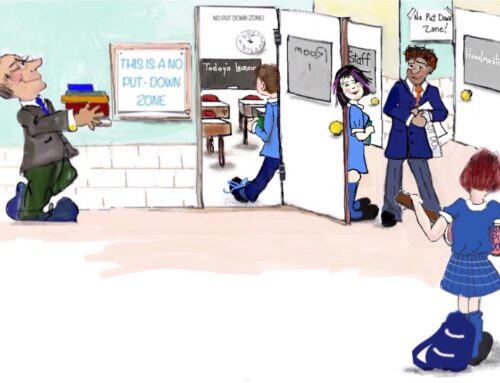A structured framework to support the re-integration of students after long term absence from school.
This program has been developed to support successful re-integration into school for:
- Students who have been excluded or suspended
- Students who have returned after a long illness
- Students who have a history of truancy
- Students who have been at home for any other reason including bereavement or psychiatric difficulties.
Some students will be returning to the same school, others will be returning to another institution.
This program can also be adapted to meet the needs of all other students who arrive mid-term with no previous connections with the school.
Where there are clear procedures in place for (re-)integrating students, time is used more effectively, and there is less need for time-consuming reactive responses when things do not work out well.
The program has three main features:
- A positive, welcoming return to school.
- A pastoral structure that enables students to be supported.
- An individual tailored program.
The aims of a re-integration program
- To assist parents/carers in meeting their responsibility to secure their children’s education through regular attendance at school.
- To foster stronger links with parents/carers by creating a collaborative situation between home and school.
- To encourage students to feel motivated to be in school, and to feel that they are part of and valued by the school.
- To provide adequate curriculum co-ordination to meet the needs of returning or recently arrived students.
Returning students may have a range of potential difficulties, which include:
- anxiety about catching up with work;
- feeling stupid because they don’t know what others know;
- fears of isolation, ridicule or being bullied;
- having to relate to many different people;
- finding their way about;
- worry about home problems;
- temptations to be with friends outside school where they feel more accepted and safe;
- responding to questions from staff and other students.
Features common to all returners
Students need to feel that they are welcome, whether they are coming to this school for the first time or not. They need clear information about the school, the timetable, the geography, the staff, uniform expectations and other rules – this should be in community languages where necessary. They need to know where they can physically go, and who to speak to, when they experience difficulties and/or need support.
Staff need clear information about the returning student, when to expect them, previous school experience, special educational needs, etc.
Parents and Carers need to have a continuing positive relationship with an identified member of staff who acts as their primary link with the school.
There needs to be preparation for the student’s arrival, especially by significant staff. This should include work expectations and social support.
There needs to be at least one review to check the progress, needs and difficulties of the returning student
 Individual needs
Individual needs
Some returning students will need
- a gradual re-integration program
- a plan to catch up on gaps in learning
- a program to promote positive behaviours
- close home-school liaison
- liaison with support agencies.
Questions to be addressed in developing a plan
What are the student’s strengths?
What can be done to limit any behavioural difficulties? What does the student want to work on?
What are the student’s skills in reading and writing?
What needs to be addressed about curriculum difficulties?
How will the student know whether they need to ‘catch up’, what to prioritise, how to get hold of past work etc?
Who does the student go to if there are difficulties – with lessons, with other things?
Does the student have anyone to link up with?
What plans will be put in place for social support? Having a friendship network is essential if the student is going to feel connected to school.
Is there a system to review how the student is getting on?
What are the arrangements for liasing with parents/carers?
Who gives feedback to the student on their successes?
What is communicated to all subject teachers and how?
How will the student know where things are, when things happen, what is expected?
Is there anywhere that can be used as a ‘refuge’ in school ?
Are there clear expectations for staff about how newly returning students will be treated? e.g. uniform, lateness, welcoming messages?
Who has oversight of this plan? When do they do it? What communication processes might need to be put in place?
Who will be the keyworker for the student? – this may be the same person who is co-ordinating or someone whose role is to be a mentor. Has the student had a say in this?
Action plan
Prior planning
- An initial informal school meeting is held with student, parent (carer) and significant staff. Parents may wish to bring a friend or community representative to this meeting.
The purpose of this meeting is to:
- explore parental concerns
- elicit parental support and make it clear to parents that the school values their involvement and that any program needs their support.
- convey the message that the school cares about the rights of students to their education and is willing to be as supportive as possible.
- give parents relevant information (in community language if necessary). Do not give parents information in meetings and expect them to read it then.
- An initial meeting is held with the student concerned, to give them the opportunity to express their concerns and wishes about the return to school. This should include their views on:
- the curriculum
- their peer group
- relations with teachers
- other concerns e.g. about lunchtimes, breaktimes.
These meetings should not need to take more than 30 minutes each
- Using the information from parents, the student and other agencies involved an individual program is planned by the pastoral team. Where necessary, subject staff and support agencies are consulted. With a good information base, this again should not need to take more than 20 -30 minutes.
The individual program will have the following features:
- The re-integration program details, including the day the student starts
- The curricular program
- Adult and peer support arrangements, including identified workers
- Review arrangements.
- A second meeting is held, in which the individual program is agreed with student parent, school and support staff. This should be not more than two weeks after the first meeting. 20 – 30 minutes should be sufficient.
The initial period of re-integration
Responsibilities of all staff
All staff need to be informed of re-integrating students and their identified key worker, both prior to the start date and again at a briefing meeting the day they return. This is to ensure that they are welcomed into the school. This means the following:
- Not picking up on minor issues, e.g. uniform, lateness, etc. Some returners will have experienced dramatic events in their lives and school regulations may not be viewed by them as serious concerns.
- Any major concern should be addressed to the keyworker before action is taken, so that carefully structured programs are not undermined by individual members of staff. Students who have been out of school for some time may simply need to be (sensitively) reminded of rules and expectations.
- Positive greetings. It is not helpful to either students or their parents for returners to be confronted with negative or sarcastic comments. A chance remark can start a slide into confrontation or withdrawal.
The curricular program may need to include arrangements for the student to be provided with work to do outside the classroom, especially in the first day or two. This may supervised, take place in the library or possibly the room next to the parents room. A full day is more than some students will be able to manage so a part-time timetable may operate for a limited period of time.
Subject staff should have written information about strengths and weaknesses of specific students and appropriate responses to these i.e does the student need a differentiated curriculum, if a non English speaker what stage are they at, what have proved to be useful strategies for a past behavioural difficulty, etc.?
The support system for returners should include linking with other students. For a limited period of time two supporters should be appointed. Ideally these should include one student who has themselves re-integrated into school after an absence and one student who speaks the same language.
The responsibility of the supporters is to:
- Be with the returner lunchtimes and break times for the first week and for longer periods by negotiation.
- Liaise with the keyworker as agreed
- Contact the keyworker if the returner misses school and take further action as agreed
- Liaise with subject teachers as appropriate.
Review arrangements
The keyworker will need to check how things are going briefly but frequently in the first instance e.g. 3-5 minutes at break, the end of the day. There should be a fuller meeting, e.g. 20 – 30 minutes, once a week for the first few weeks, especially for those pupils with particular attendance or behavioural difficulty.
A full review with parents, student, keyworker and student supporters should be held after three to four weeks of the re-integration program (30 minutes). Further reviews would be negotiated at this meeting.
INFORMATION CHECKLIST FOR STUDENTS RE-INTEGRATING
Name and details of student:
Community language:
Stage:
Previous educational history: Where, for how long, reason for leaving:
Involved agencies, if any, named workers if possible:
Health issues:
Special needs:
Literacy needs:
Learning needs:
Parents views/ concerns:
Getting up and getting to school?
Homework facilities
Uniform/ equipment
Other relevant home factors
Any medication or other health provision
Students views/ concerns:
Curriculum issues:
- Which subjects does the student perform best in?
- Which subjects pose difficulties for the student?
- Concerns about catching up on work missed.
- Concerns about the timetable – knowing where to be when.
- Homework issues
Relationships:
- With teachers
- With peers
- (Does the student know anyone in the school already – explore keyworker and ‘buddy’ possibilities)
Lunchtimes and breaks – preferred options
Other concerns – and what does the student feel would be most helpful to them in successfully re-integrating into school?
INDIVIDUAL EDUCATION PLAN FOR STUDENTS RE-INTEGRATING: CONTENTS
Name
Start Date
Tutor Group
Keyworker
Arrangements for meeting with Keyworker
Other agencies
Student supporters
Responsibilities of student supporters
Curriculum arrangements:
i.e. full day, part-time, out of class, where , who with, etc?
Arrangements for catching up on past work (if appropriate.)
Monitoring arrangements
Full review date:
Parents/others in agreement / notified?








Leave A Comment
You must be logged in to post a comment.